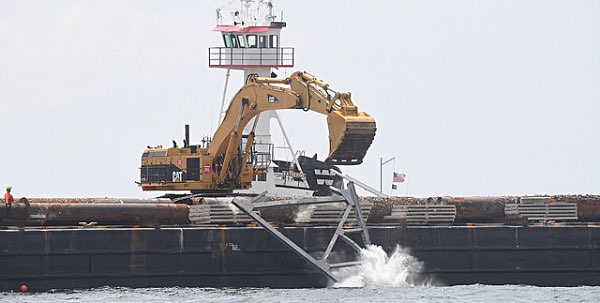- By New York State Governor's Office
- Around Town
 Print
Print 
Governor Andrew M. Cuomo deployed the first installation of recycled materials thursday from the former Tappan Zee Bridge, as well as former Canal vessels, in the Shinnecock Reef, launching the Governor's initiative to significantly expand New York's network of artificial reefs. Announced in April, the program is poised to bolster 12 artificial reefs off the shores of Long Island—the largest expansion of artificial reefs in state history. The materials for the reef expansion will be strategically placed to improve New York's diverse marine life and boost Long Island's recreational, and sport fishing and diving industries. In addition to the inaugural expansion of the Shinnecock Reef announced today, five additional reef sites will be enhanced this year at sites off the shores of Smithtown, Moriches, Fire Island, Hempstead, and Rockaway.
"Long Island's economy thrives when there are fish for anglers to catch and recreational opportunities to explore marine life along the coast," Governor Cuomo said. "These artificial reefs are an investment in a stronger, more diverse marine ecosystem that will bolster the economy and bring a new purpose to the former Tappan Zee Bridge that will continue to serve New Yorkers for generations to come.
At the Governor's direction, and with unprecedented, multi-agency coordination, recycled materials from the Department of Transportation, Canal Corporation, and the Thruway Authority will be used to develop New York's artificial reef sites and increase the biodiversity of these habitats for a variety of fish and lobsters. Construction of New York's first artificial reef dates back to 1949, and this latest initiative marks the state's first coordinated effort to stimulate the full environmental and economic benefits of artificial reefs.
Yesterday, a total of 1,093.2 tons of materials were added to the Shinnecock Reef. Barges dropped 885 tons of clean, recycled Tappan Zee Bridge material, as well as deconstructed New York State Department of Transportation project materials, including:
- 35 tons of triangular trusses
- 100 tons of concrete deck panels
- 750 tons of steel foundation pipes
- 6 tons of steel lattice trusses
- 13.1 tons of pieces of steel sheeting
- 37 tons of steel beams
- 13.8 tons of steel columns
- 9.4 tons of steel girders
- 0.9 tons of steel channels
- 128 tons of steel pipes
New York's marine resources are critical to the state's economy, supporting nearly 350,000 jobs and generating billions of dollars through tourism, fishing and other industries. More than 500,000 anglers in the region will reap the benefits of this initiative, supporting the region's growing marine economy which accounts for approximately 9.7 percent of Long Island's total GDP.
Throughout the summer, state agencies will be deploying 33 barges of Tappan Zee Bridge recycled materials and 30 additional vessels that have been cleaned of all contaminants. A total of 43,200 cubic yards of recycled Tappan Zee Bridge material, 338 cubic yards of steel pipe from DOT, and 5,900 cubic yards of jetty rock will be submerged and added to six reef sites as part of the first phase of this initiative.
DEC manages New York's Artificial Reef Program, which includes two reefs in the Long Island Sound, two in the Great South Bay, and eight artificial reefs in the Atlantic Ocean. The major benefits of constructing New York's artificial reefs include improving the existing habitats in order to increase local marine biodiversity, stimulating more productive and diverse aquatic ecosystems, and promoting environmental sustainability through fish habitat improvement.
The reefs are built out of hard, durable structures such as rock, concrete, and steel pipes, and usually in the form of surplus or scrap materials that are cleaned of contaminants. After materials and vessels settle to the sea floor, larger fish like blackfish, black seabass, cod, and winter and summer flounder, move in to build habitats within the new structures, and encrusting organisms such as barnacles, sponges, anemones, corals, and mussels cling to and cover the material. Over time, all these structures will create habitat similar to a natural reef.
Artificial reef construction is part of Governor Cuomo's NY Open for Fishing and Hunting Initiative, an effort to improve recreational activities for in-state and out-of-state sportsmen and sportswomen and to boost tourism opportunities throughout the state. Visit here for more information about DEC's Artificial Reef Program.
v14i21



